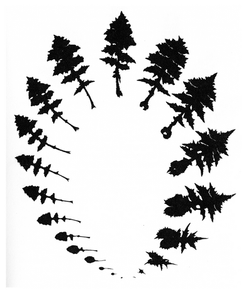Metamorphosis of Plant Leaves
- Christoph Hueck (DE)

- Aug 29, 2023
- 2 min read
Updated: Oct 16, 2023
Christoph Hueck (DE)

Dicotyledonous flowering plants show a more or less pronounced transformation in the shape of their leaves, a phenomenon that has given rise to many Goethean studies. The study of leaf metamorphosis is a particularly good way to practise mobile and imaginative thinking that is suitable for grasping the formative forces of living beings in general.
Fig. 1 shows the example of the hedge mustard and the gallery contains many other examples from Goethean publications. In most cases the leaves have been arranged in a loop so that the lower leaves can be seen at the bottom left and the last upper leaf before the calyx at the bottom right.

Metamorphosis follows similar formative principles in all these cases. The lower leaves have a long petiole that successively shortens towards the top. The leaf blade initially expands in roundish shapes, then becomes more and more differentiated and finally disappears in increasingly pointed shapes. In the case of the common sowthistle (Sonchus oleraceus), the base of the leaf also widens towards the top, so that there is a complete reversal of formation between the lower and upper leaf (Fig. 2).

Goethe described leaf-metamorphosis in general terms of expansion and contraction. Jochen Bockemühl has described the leaf-forming activities in more detail, calling them "stemming" (forming stems), "spreading" (enlarging the surface), "articulating" or "differentiating" (differentiating the forms) and "pointing" (retiring of the leaves)[2] (Fig. 3, cf. The four elements as modes of cognition and the metamorphosis of plant leaves). This does not indicate the fixed forms of the leaves, but the actively forming principles. They must be comprehended and experienced in inner activity.
The last two pictures in the gallery show the continuous transition of forms from foliage to petal, to stamen and to carpel in the peony. The last picture is of a double peony in which even the carpels are once again transformed into petals before the metamorphosis finally ends with very small carpels (from Suchantke 1982[5]). Note that there is a jump between the stamens and the carpels (arrows); the separation into the two sexes is not continuous but abrupt.
Literature:
[1] Bockemühl, Jochen: Der Pflanzentypus als Bewegungsgestalt. Gesichtspunkte zum Studium der Blattmetamorphosen. In: Goetheanistische Naturwissenschaft II. Botanik. Stuttgart 1982a, S. 7–16.
[2] Bockemühl, Jochen: Bildebewegungen im Laubblattbereich höherer Pflanzen. In: Goetheanistische Naturwissenschaft II. Botanik. Stuttgart 1982b, S. 17–35.
Engl: Transformation in the foliage leaves of higher plants. In: Goethe's way of science. A phenomenology of nature. New York 1998, pp.115-128.
[3] Bockemühl, Jochen: Die Bildebewegungen der Pflanzen. In: Erscheinungsformen des Ätherischen. Wege zum Erfahren des Lebendigen in Natur und Mensch. Stuttgart 1985, S. 107-134.
[4] Suchantke, Andreas: Metamorphose, Kunstgriff der Evolution. Stuttgart 2002; Rispens, Jan Albert: Bäume verstehen lernen. Ein goetheanistisch-anthroposophischer Schulungsweg an der Natur. Stuttgart 2014, S. 33.
[5] Suchantke, Andreas: Die Zeitgestalt der Pflanze. In: Goetheanistische Naturwissenschaft II. Botanik. Stuttgart 1982, S. 55–81.
[6] Hoerner, Erdmut-M.W.: Der Goetheanismus und die Wiedergewinnung der Trinität. Ein urchristlicher Impuls. Stuttgart 2018, S. 37.
[7] Hoffmann, Nigel: Goethe's Science of the living form. The artistic stages. 3rd ed., Hillsdale, NY 2022.
[8] Hoffmann, Nigel: The university at the threshold. Orientation through Goethean science. Forest Row 2020.
[9] Brady, Ronald H.: The idea in nature. Rereading Goethe's organics. In: Goethe's way of science. A phenomenology of nature. N.Y. 1998, p. 94.
































Comments